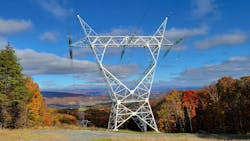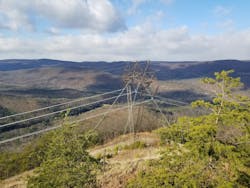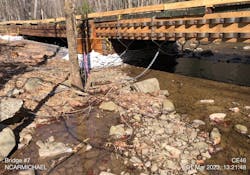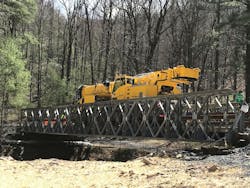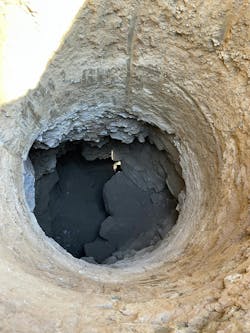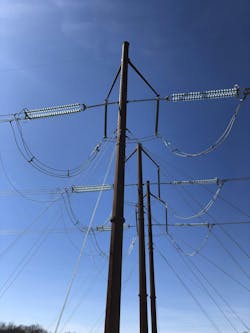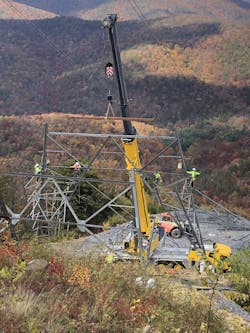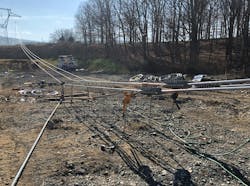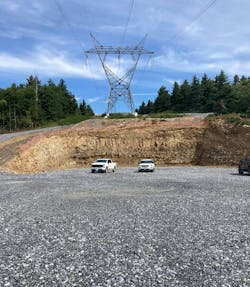Dominion Energy Rebuilds Mt. Storm to Valley Line
Listen to the Audio Story on the Line Life Podcast
The Mt. Storm to Valley line 550 acts as an energy superhighway, traversing across two states and serving as a critical feed to Dominion Energy Inc.’s entire service territory. Part of the original 500-kV electric transmission loop built in North America — spanning from West Virginia, to Maryland and back to Virginia — the line was first built in 1965 with weathering steel guyed towers. The line needed to be replaced due to age and corrosion.
The rebuild project faced significant challenges, including difficult mountainous terrain, changing regulations and complex engineering solutions, all of which were successfully addressed to ensure the line’s reliability and performance for the future.
Paving the Way
The construction methods used to access and rebuild the Mt. Storm to Valley line required in-depth analysis and consideration. This project was highly complex because of its location. Access was difficult due to extreme mountainous terrain, limited roads and multiple stream crossings. In addition, the length of the project — 64.5 line miles (103.8 km) and over 115 road miles (185.1 km) — made accessing the right-of-way a logistic challenge. Getting large tractor trailers loaded with materials to the construction sites was often a precarious and slow process due to the tight circuitous forest roads.
For example, phase 3 of the project was located on U.S. Forest Service (USFS) land. This phase contained 58.4 miles (94 km) of roads to access 20 miles (32.2 km) of transmission lines. Traveling throughout the project area took an incredible amount of time. Often, several miles of access roads would need to be traveled between structures, with only one ingress and egress, this made road building incredibly complicated. Crews excavated 511,000 cu yards (390,688 cu m) of native material out of the area and installed 561,000 tons of stone for stable, compacted roads and work pads.
The sheer amount of earth that had to be moved culminated in tens of thousands of trips up and down narrow mountain roads creating vehicle congestion. The drive time from one structure to another could be over 45 minutes, and the time back to the material yard could be 2 hours. Several roads were barely wide enough for one truck, making it impossible to have multiple trucks traveling toward each other from opposite directions. To prevent accidents or trucks meeting on the one-way roads, the project team quickly recognized the need to organize these trips and create a communication plan. To mitigate this, crew leaders installed mile-marker signage and created a communication process to coordinate the flow of construction traffic.
Engineering Complexities
The road building crews had a steep challenge to construct roads to each line structure as well as cut drilling pads, crane pads and pull pads into mountain sides — all while staying within the permitted limits of disturbance. For example, a tensioner pad was approximately 100 ft wide by 200 ft long (30.5 m by 61 m) and had to be graded within 1% or 2% of being level. This level surface was necessary to operate the large tensioner equipment safely as well as to have enough space to line up 18 reels of conductor and four reels of fiber.
The forest roads on USFS property that Dominion Energy used in phase 3 were overgrown and in poor shape. Many roads were extremely narrow and barely traversable in a pickup truck due to several decades of neglect. The Mt. Storm project rebuilt these roads to a minimum of 14 ft (4.3 m) wide. Several portions were built much wider to accommodate 240-ton, multi-axle cranes and tractor trailer traffic, which required a turning radius of 55 degrees.
For phases 1, 2A and 3, Dominion Energy installed a total 115 miles (185 km) of road, moved over half a million yards of material, imported over half a million tons of stone, and installed 73 miles (117.5 km) of erosion and sediment controls (for example, silt fence and silt sock) as well as approximately 1.2 miles (1.9 km) of culvert pipe. The utility also installed two permanent bridges on private land, one of which was over 200’ long over the south fork of the Potomac River. Dominion Energy evaluated the existing 75-year-old low water bridge crossing and determined it was not adequate for heavy equipment requiring the solution of a new bridge. To allow construction traffic to cross existing fords, we installed 15 temporary low-water crossings on USFS property. These temporary bridges had to be specifically designed to meet the USFS’s stringent low water crossing criteria, an effort that took two years to get approved by the Forest Service.
Mt. Storm’s elevation posed ongoing challenges. During winter, severe weather — snow, ice, high winds and fog — limited construction activities near the substation. After roads and work pads were cut into the mountain slopes, another difficulty arose in constructing the towers, as there were few flat areas for staging and erecting the lattice members. As a result, most towers had to be assembled in much smaller segments and assembled in the air due to the lack of flat ground.
Environmental Mitigation
From an environmental standpoint, Dominion Energy had to evaluate more than 200 different animal species to determine whether their habitats would be impacted by the Mt. Storm to Valley line project. After extensive studies, the utility identified four species — the Cow Knob salamander, long-eared bat, wood turtle and brook trout — as potentially affected. With significant time and effort, the habitats of these species were carefully mitigated to prevent any harm. There was not a single month of the year that was not encumbered by some time of year work restriction.
Additionally, during the project, a bat cave was discovered within a right-of-way corridor. To ensure its protection, experts were brought in to monitor the cave and identify the species of bats residing there. Ground-penetrating radar was also used to determine the full size and location of the cave and ensure foundation installation would not compromise the habitat.
Changing Regulations
Gaining access to the structure sites was a constant challenge. The mountainous terrain in phases 1, 2A and 3 was especially challenging for roadbuilding in the West Virginia Department of Environmental Protection and USFS portions of the project due to changing regulations.
When revisions were made to the West Virginia construction general permit (CGP) in 2019, Dominion Energy had to totally revise its road plans in the state to be completely engineered with plan and profile (overhead and side) views, and cross-sections had to be included every 100 ft (30.5 m). The level of detail required was like that of a highway project.
Additionally, the USFS enacted stringent standards for land disturbances and required all earthwork, including temporary work, to be placed in fully engineered plans and submitted for review. This made any necessary field revisions nearly impossible to implement in a timely fashion.
Park Communication
Public notification was another aspect of the Mt. Storm to Valley line project that required in-depth planning. The project had the potential to impact George Washington National Forest visitors. Partnering with USFS, Dominion Energy developed an app to keep park visitors informed on construction and road statuses. The site showed open roads with no construction, roads closed due to construction and available detours. Dominion Energy promoted the app in local newspapers and ran digital ads on social media platforms. This comprehensive communication approach benefited park visitors by minimizing disruptions during active transmission line construction.
Innovative Tower Design
The Mt. Storm to Valley rebuild called for the replacement of over 260 structures in challenging, remote terrain, requiring the extensive road building plans mentioned above. Three-quarters of the towers needed custom-designed leg extensions to ensure the foundations were within acceptable ranges. For example, structure 550/131 had the largest elevation change across a single tower, with a 30-ft (9.1-m) difference between its first and third legs.
The project required the creation of a new family of towers, specifically designed to replace the existing guyed structures with self-supporting galvanized steel towers. The 5C lattice steel towers were built to withstand the region’s intense weather conditions. The 5C towers, designed by Dominion Energy’s standards department, featured a larger central window to improve climbing clearance for line workers. With half of the line’s elevation over 2000 ft (610 m) — and some sections even reaching 3000 ft (914 m) — the towers were designed to meet extreme ice design criteria of 2-inch (50.8-mm) thick wires and towers.
Galvanized steel was selected to prolong the lifespan of the structures. Thicker steel members and a large box footprint were used to create stout, self-supporting towers, minimizing maintenance needs and increasing resilience to any cascading line events.
The new 5C light tangent (5CLT) and 5C heavy tangent (5CHT) towers accounted for 80% of the new structures. For towers with large foundation reveals on side slopes, 2.5-ft (0.76-m) leg extensions were used. The 5C extra-heavy tangent (5CXHT) suspension V-strings were made from bundle 66k glass insulator bells to reliably handle over 3000-ft (914-m) weight spans, as they could very likely get covered in over 1 inch (25.4 mm) of ice.
Custom fiber deadend and suspension assemblies were created for the mega spans by using yoke plates and insulators in parallel. The fiber itself was a dual-layered Alumoweld with 36 fibers in the core and a maximum tension design of 47,155 lb (21,389 kg). The new conductors and shield wires were designed to handle more extreme weather events, higher electrical loads and improved ground clearances. These updates met current industry standards for reliability and performance in the region’s harsh weather conditions.
Making Modifications
In one area where a mountain slope made it impossible to construct a traditional wire pull pad at a deadend tower, construction crews adapted their approach. They used Kellems grips to pull two reels of wire together, stopping the wire grips precisely on an intermediate deadend tower. This approach enabled the utility to avoid having to install an extra splice in the line. Crews worked with vigilant care to successfully pull two reels totally approximately 18,000 ft (5486 m) of triple-bundle 1351 ACSS/TW/HS-285 Martin wire across the mountains.
Additionally, permitting delays required modifications to the original line design. Double deadend towers were added or swapped to ensure stopping points were located outside the forest at both ends of phase 3. At another one of these new stopping points a direct-embed guyed three-pole double deadend structure was installed. At each transition point, from the new triple-bundle wire to the existing two-bundle wire, a trifurcator-to-bifurcator connection was used in the jumper loops.
The project also faced significant elevation changes that impacted wire tension during installation. To address these challenges, offset clipping was frequently required to equalize tension in the wire pulls. Phase 2 was the only phase that did not require calculating offset clipping reports. Careful coordination between engineering and field crews was essential to have the data for the temperature range in time for the wire sagging operations. Values from the charts were also used to verify the sag in the blocks before applying the offsets.
Project Success
Despite the shear number of challenges, Dominion Energy’s project team and crews successfully completed the Mt. Storm to Valley rebuild by the scheduled energized date of December 2023. The project was a remarkable achievement in engineering, roadbuilding, permitting and construction. It stands as a testament to the creativity, perseverance and commitment to quality displayed by the entire team.
With this rebuild, Dominion Energy fully utilized the existing right-of-way, kept structures in the same general location as the existing structures, addressed long-term reliability needs and improved durability without requiring excessive maintenance.
About the Author
Bobby Capehart
Bobby Capehart ([email protected]) is a superintendent in the electric transmission construction group at Dominion Energy Virginia. He is responsible for road building, and other civil construction related activities necessary to support transmission line construction projects. Additionally, his group is responsible for maintaining environmental compliance with all associated project permits. Bobby has been with Dominion since 2011 in various roles.
Matthew Vinson
Matthew Vinson ([email protected]) is a consulting engineer at Dominion Energy. He has been designing transmission lines for 12 years and has been involved in many complicated line projects over the years from 115 kV temporary lines up to several 500 kV rebuilds. He recently completed his largest 500 KV rebuild and is now focused on greenfield 500 kV lines in the data center region of Virginia, as well as mentoring new engineers.
